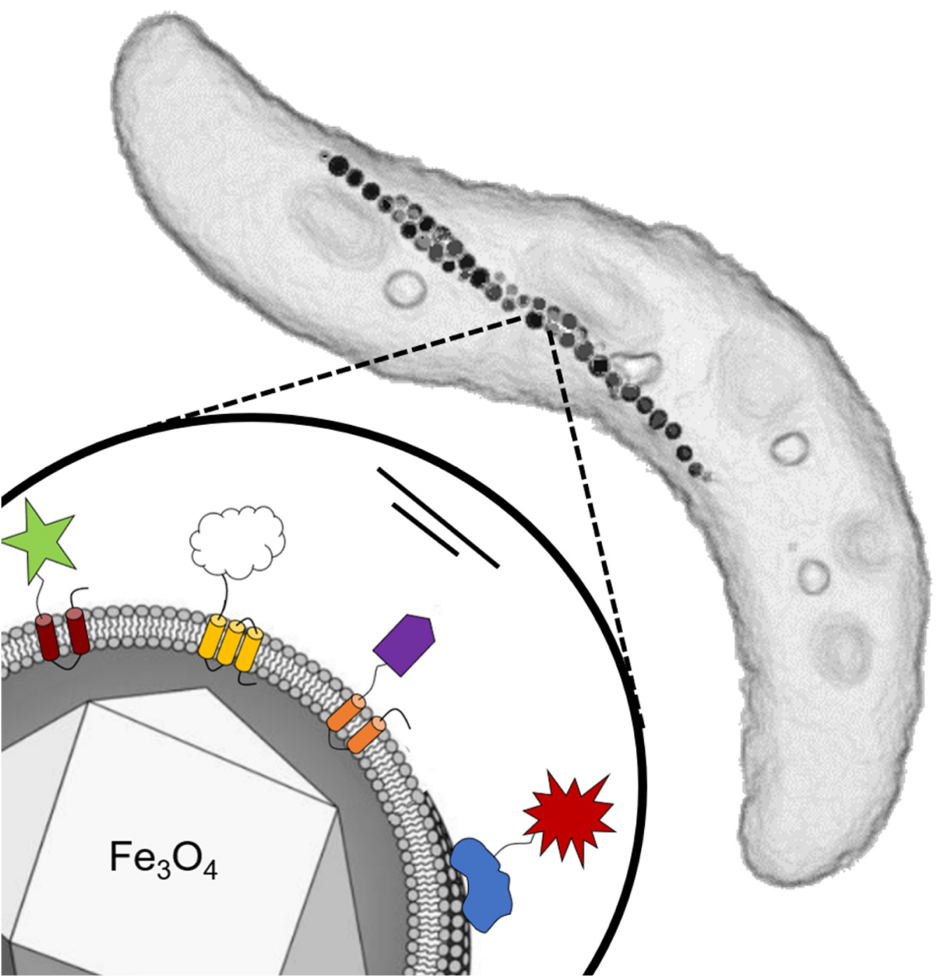Mar 25 2020
Innovative biomaterials could soon be produced using magnetic bacteria. Headed by Professor Dr Dirk Schüler, a group of microbiologists at the University of Bayreuth has created a new, modular system to genetically reprogram bacteria and thus convert these pathogens into cell factories for multifunctional magnetic nanoparticles—nanoparticles that integrate numerous useful properties and functions.
 Top right: Schematic of a cell of the magnetic bacterium Magnetospirillum gryphiswaldense used in this study, showing its intracellular chain of magnetosome particles. Each cell has a length between three and five micrometers. Bottom left: Single magnetosome with an iron oxide core enveloped by a membrane. Different functional groups from foreign organisms were genetically fused to specific proteins of the magnetosome membrane. Image Credit: Frank Mickoleit/Clarissa Lanzloth.
Top right: Schematic of a cell of the magnetic bacterium Magnetospirillum gryphiswaldense used in this study, showing its intracellular chain of magnetosome particles. Each cell has a length between three and five micrometers. Bottom left: Single magnetosome with an iron oxide core enveloped by a membrane. Different functional groups from foreign organisms were genetically fused to specific proteins of the magnetosome membrane. Image Credit: Frank Mickoleit/Clarissa Lanzloth.
These nanoparticles have good biocompatibility and excellent magnetic properties, making them a potential, new material in the field of biotechnology and biomedicine. The researchers have described their findings in the Small journal.
From Magnetosomes to Versatile Nanoparticles
Magnetic bacteria belonging to Magnetospirillum gryphiswaldense species align their swimming behavior along the magnetic field of Earth. Magnetic nanoparticles—called magnetosomes—inside the cells are organized in a chain-like fashion, thus creating an intracellular compass needle.
Every magnetosome includes a magnetic iron oxide core that is enclosed by a membrane. This membrane includes a range of different proteins, apart from lipids. At the University of Bayreuth, the microbiologists effectively coupled biochemically active functional groups to these proteins. These functional groups emerge from different foreign organisms.
The technique used in this study begins at the stage of the bacterial genes that are involved in the biosynthesis of the membrane proteins. Such bacterial genes are attached to foreign genes from other organisms that regulate the synthesis of the respective functional proteins.
Once the genes are re-incorporated into the genome, the bacteria that had been reprogrammed create magnetosomes that exhibit these foreign proteins. These bacteria were permanently fixed to the surface of the particles.
In the analysis, the membrane proteins were coupled with four different functional groups (that is, foreign proteins). These functional groups include glucose oxidase, an enzyme produced by a mold fungus, which has already been used biotechnologically, for instance as a “sugar sensor” in diabetes diseases.
Moreover, a dye-producing enzyme produced by the bacterium Escherichia coli—the activity of which can be easily quantified—and a green fluorescent protein from a jellyfish were loaded onto the magnetosomes’ surface. An antibody fragment from a lama (Alpaca) represented the fourth functional group and this was utilized as a multipurpose connector. Thus, the bacteria were genetically encoded with all these characteristics, including the excellent magnetization of the magnetosomes.
Using this genetic strategy, we reprogrammed the bacteria to produce magnetosomes that glow green when irradiated with UV light and at the same time display novel biocatalytic functions. Various biochemical functions can be precisely installed on their surfaces. Thereby, magnetosomes from living bacteria are transformed into multifunctional nanoparticles with fascinating functions and properties.
Dr Dirk Schüler, Study Lead and Professor, Department of Microbiology, University of Bayreuth
Dr Schüler continued, “Moreover, the particles remain fully functional when they are isolated from the bacteria - which can be easily performed by taking advantage of their inherent magnetic properties.”
A Genetic Toolkit for Applications in Biomedicine and Biotechnology
Functionalization of the magnetosomes is certainly not restricted to the functional groups that were adhered to the particle surface by the team of microbiologists at the University of Bayreuth. Rather, these proteins can effortlessly be substituted by other functions, thereby offering an extremely multipurpose platform.
Hence, genetic reprogramming paves the way for a broad spectrum to engineer the surface of magnetosomes. It offers the foundation for a “genetic toolkit” that helps to create customized magnetic nanoparticles, assimilating different useful properties and functions. All these particles measure 3–5 nm in size.
Our genetic engineering approach is highly selective and precise, compared to, for instance, chemical coupling techniques which are not as efficient and lack this high degree of control.
Dr Frank Mickoleit, Study First Author and Microbiologist, University of Bayreuth
Dr Mickoleit pointed out a decisive benefit of the novel biomaterials, “Previous studies show that the magnetic nanoparticles are likely not harmful to cell cultures. Good biocompatibility is an important prerequisite for the future application of the particles in biomedicine, for instance as contrast agents in magnetic imaging techniques or as magnetic sensors in diagnostics.”
“In the future, for example, similar particles might help to detect and destroy tumour cells. Bioreactor systems are another field of application. Magnetic nanoparticles equipped with tiny catalysts would be highly suitable for this purpose and enable complex biochemical processes,” Dr Mickoleit added.
There is an enormous application potential for nanoparticles that display different functional groups on the surface, particularly in the fields of biotechnology and biomedicine. The magnetic bacteria now may serve as a platform for a versatile nano-toolkit, inspiring scientific creativity in the field of Synthetic Biology. It will initiate further interesting research approaches.
Clarissa Lanzloth B.Sc., Microbiologist, University of Bayreuth
Lanzloth was also involved in the latest study as co-author during the conclusion of her Master thesis in “Biochemistry and Molecular Biology” at the University of Bayreuth.